Boost Your Game With These Fly Fishing Techniques
May 08, 2020

As an Amazon Associate, Modded gets commissions for purchases made through links in this post.
The water, the quiet and the rhythm of the cast. Fly fishing is having a renaissance these days, with rampant popularity amidst the younger generations. Whether you’re a beginner or advanced angler, here are some fun fly fishing techniques to improve your performance.
1. Set Up Droppers
You can use droppers, which function as a second bait, with both dry flies and nymphs. This technique allows the angler to make precise customizations based on a set of criteria, whether it be weather conditions, type of trout or location. You can set up a dropper at the end of the tippet with the dry fly or a bit removed, though the length depends on your specific scenario.
2. Wind Casting
Fly fishing becomes a delicate balance of skill and luck when anglers meet poor weather conditions. Windy conditions can be especially tricky, but using a graphite rod can make your cast easier to manage, especially in conjunction with a shorter line and a heavier fly. Weighted nymphs are most effective when mimicking the way that wind disrupts the water’s surface.
3. The Belgian Cast
Knowing when to use which type of cast is an essential step in fly fishing. Anglers commonly use a Belgian cast in coordination with heavier or multiple flies. It’s also referred to as an oval cast because, instead of whipping the line back and forth, you move it in a circular motion that provides consistent tension.
4. Skate a Spider
Skating a spider functions similarly to how it sounds. Using a dry fly, you want to pull the line in a series of twitchy strokes so that the bait skates across the surface like an insect. The rapid movement is sure to catch the attention of hungry fish, making it an excellent technique to yield a surface-level catch.
5. The Bow and Arrow Cast
The bow and arrow cast is an excellent method when you are fishing in a cramped space. Pulling back on the line manually and slightly bending the rod, it allows anglers to be precise in their target. This cast can be a tricky technique to master, but once you get the hang of it, it can be incredibly helpful.
6. The Puddle Cast
In trout fishing, one vital step when setting up your position is to make sure you respond to their standard feeding behaviors. The puddle cast is excellent when you’re fishing for trout, coordinating a series of S-shaped casts. Using varied height in the back and front cast, the angler can position the fly in a way that allows it to fall downstream naturally.
7. Dead-Drift a Streamer
Flies can either act as attractors or imitators. Imitators tend to resemble food that trout eat regularly, while attractors appear as a foreign interest. Streamers are a second lure attached to the end of the line and designed to float below the fly. Dead-drifting is the process of dropping the line and allowing the streamer to drift down below the surface. This technique is ideal for fishing in areas of greater depth, such as rivers or lakes.
8. Dry Fly and Dropper Nymph Setup
While using a dry fly as an indicator or strike tends to be a beginner’s technique, this setup is a bit more complex. The benefit of using both a dry fly and a dropper nymph is that you can position the nymph right below the surface with great accuracy. As a rule of thumb, attach your dropper to a tippet between eighteen and twenty-four inches long. The length will vary depending on weather conditions and current speeds.
9. Adjust Tippet Length
The size of your fly determines the length of your tippet, the thin string attached to the end of your line that’s invisible to fish. However, it is also the most delicate part of the line and can easily break. Adjusting the tippet length based on the size of your fly will improve the likelihood of your cast functioning properly, and lessen the number of repairs you have to make.
10. Leisenring Lift
Anglers often use the Leisenring lift in upstream casts. With a wet fly or nymph, you can allow the lure to drift down into the water and then stops the movement of the rod so that it appears to float quickly to the surface. This movement mimics prey rising to the water’s surface and attracts the attention of the fish.
Fly Fishing Techniques That Will Enhance Your Game
Do you want to become an expert fisherman and excel in this sport? If so, try out the fly fishing techniques above. From wind casting to the dropper nymph setup, you’ll be pulling out a catch in no time.





